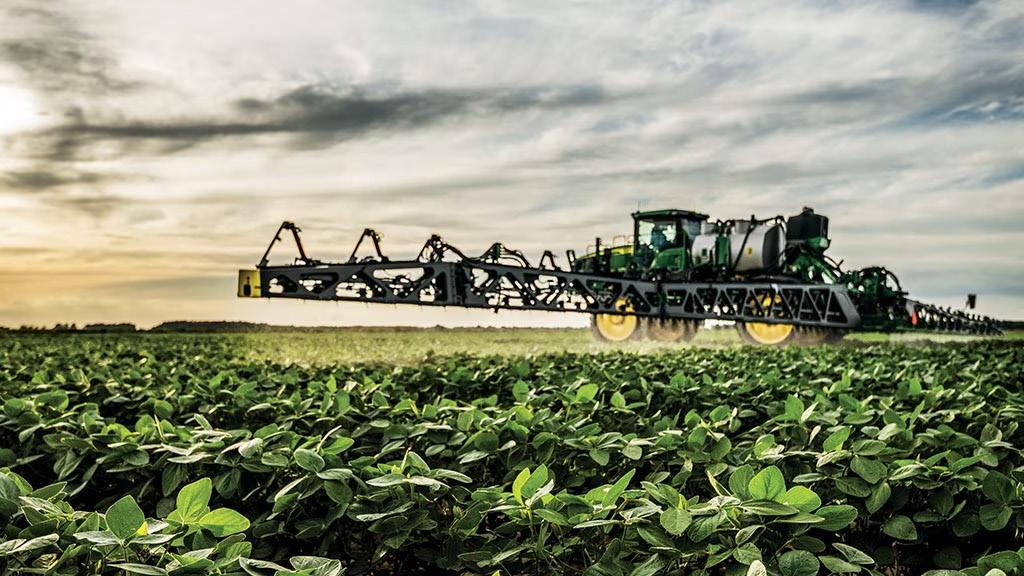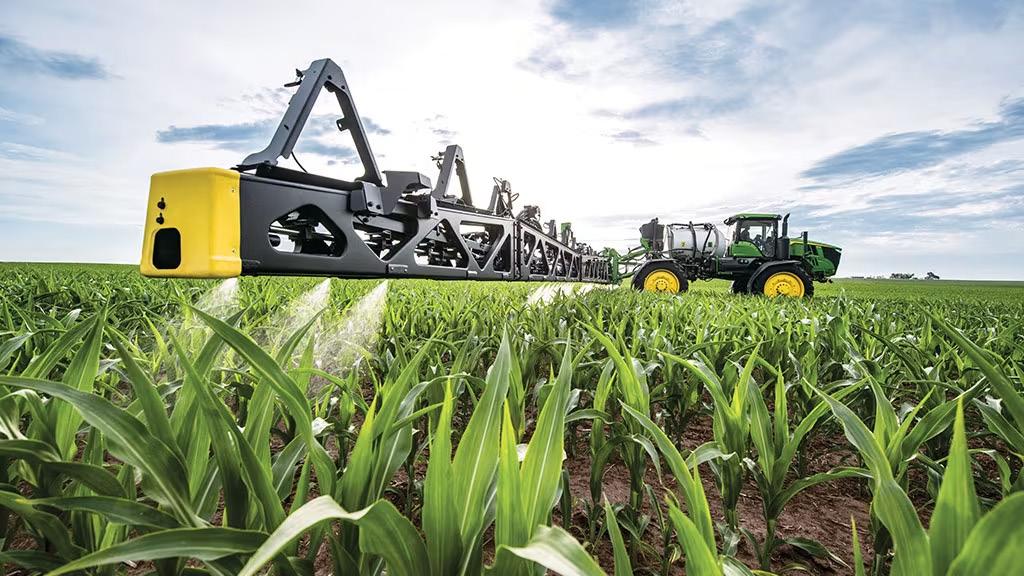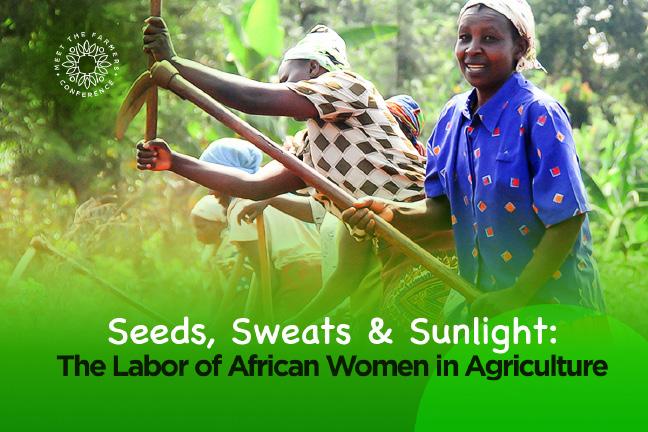
7 minute read
See & Spray™ Ultimate
INPUT SAVINGS
Reduce Herbicide Use
Advertisement
See & Spray Ultimate can reduce non-residual herbicide use by more than twothirds by target spraying weeds.1
BATTLE HERBICIDE RESISTANCE
Efficient Weed Control with Dual Tank
The sprayer’s two tanks enable you to combat herbicide resistance by using two independent tank mixes in one pass, avoiding antagonism that occurs when certain inputs are combined. Go with 1,000-gallon total capacity (3,785L), a 1,200-gallon (4,542L) option, or a 1,600 gallon (6,057L) option.

SUSTAINABILITY
Targeted Spray Benefits
See & Spray™ Ultimate delivers a targeted spray2 to weeds, applying herbicide only where needed. Plus, our ExactApply nozzle control technology helps reduce potential drift.


Ginger is one of the many cash crops that is grown on the fertile soil of Africa. We drink, spice our food, bake our cookies, and benefit from its antioxidant and medicinal properties. It contains Gingerol, an active ingredient in the treatment of inflamed arthritic joints, infections, high cholesterol, stomach cramps, cold, fever, diarrhoea, etc.
Background
Ginger is one of the strongest spices in the world, dating back to 5000 years AD. The earliest mention was in the writings of Confucius, an ancient Chinese philosopher, and the Romans. It was first discovered among the Austronesia people in South-East Asia before it graced the East African soils.
The Austronesians used it for rituals, for healing, and in blessing their ships. In the first millennium, it was later carried in voyages to the Pacific Islands, India, and off to Madagascar and Comoros. The
14th century holds the earliest records of trade and barter; a pound of ginger in exchange for a sheep.
Cultivation
Ginger is a herbaceous perennial crop that is cultivated in the humid tropics. There are about 50 known species of ginger in Africa. It is a root crop with trumpet-shaped and scented flowers that appear in lilac, pink, pale yellow, or white variants. It has small, berries-like fruits, and its leaves smell like the crop. Ginger grows well on fertile, well-drained soil, and humid environments. It grows between 300m and 900m high, and 30cm depth.
The seed or rhizome is first treated before planting to prevent pest infestation and diseases. The soil is cleared and ploughed 12 inches deep and 24 inches apart. The preferable planting season is between May and June where there is low rainfall.
The farmer then weeds, applies fertilizer, and spreads green leaves on the plant beds, 45 to 90 days after planting. This process is defined as mulching and it is done to conserve soil moisture. The crop should be rain-fed or irrigated every two weeks to ensure high-quality yield. Harvest takes place between 4 to 5 months after planting.
Nigeria is the largest producer of ginger in Africa and the third-largest exporter in the world after India and China. South Africa, DR Congo, Malawi, Zimbabwe, Tanzania, Zambia, and Ghana.
Written by Joy Ejere Uche
Maintaining farm equipment is important since most of them are prone to expensive breakdowns and can be hardly cheap. If for any reason farm equipment is not maintained while in use, it will probably not perform as expected. There are several ways of maintaining farm equipment, but every farmer should adopt these 7 simple tips.

Operator Training
There are different types of farm equipment used for farming activities, however, they all operate in different ways. If you, as a farmer, operator, or manager, knows how to effectively man the farm equipment, then the chances of missing out on maintenance are lowered.
Lubricate Your Equipment
There’s nothing as ineffective as a part of equipment undergoing friction as a result of rust. Be sure to always apply good quality lubricants to every movable part of your equipment. It will enhance good performance and longer life expectancy for your equipment.
Check for Signs of Wear
It is possible for your farm equipment to be in perfect shape and excellent condition once you
Keep Farm Equipment Clean
Maintain a proper cleaning routine such as filter cleaning, build up removal, vacuuming and dusting inside farm equipment so your equipment will look great for a longer time to come.
Have A Maintenance Schedule
The best way to be sure that your farming tools and machinery are in good shape is by having a proper maintenance schedule. This way, you are rest ensured that you are not missing out on repairing farm equipment. It is also recommendable to take operator training lessons especially if you are working with sophisticated farming equipment.
Keep Children and Animals Off Equipment Building
Farms offer a world of adventure for curious kids. To avoid any disastrous accidents, keep your child’s play area separate from your work area. Know where your children are even when you are mowing the lawn. Don’t let a split-second accident impact your child forever.
Observe Safety Precaution Measures
The spread of infectious diseases like COVID- 19 demands that we adhere to safety precaution measures. Ensure to wash your hands with clean water and soap before and after the use of every farm equipment. In cases where water and soap are not readily available, use hand sanitizers. Avoid bringing your hands in close contact with your eyes and mouth.
check for signs of wear. Did you discover a sign of wear and tear on any part of your equipment? Ensure to replace the part as soon as possible to prevent a major breakdown from happening.
In conclusion, farm equipment is a crucial investment that you cannot afford to lose. It should serve you for years, and the best way to ensure that it stays in service for as long as possible is by taking proper care of it. These simple maintenance tips should get you started and keep your farming equipment safe and effective.

Written by: Nene Nseabasi
Global climate change is one of the most significant challenges of our time. The extreme weather conditions, change in rainfall, temperature, and humidity patterns have a drastic impact on agricultural activities and yield.
Agriculture is greatly affected by the global climate shifts caused by the Greenhouse effect. The release of malign gases such as carbon dioxide, methane, and nitrogen dioxide depletes the ozone layer and leads to an increased risk of flooding, soil erosion, droughts, and wildfires. It invariably decreases crop productivity and affects the global agricultural value chain. Researchers are looking at alternative farming techniques, as well as solutions to the environmental condition. Thus, the need for farmers and all agro stakeholders to adopt a sustainable solution to avoid a global food crisis.
The first step in addressing the impact of climate change on food production is to inform the farmers. They need to understand the causes and consequences of environmental challenges and mitigate them through safer farm practices.
Farmers need to understand the risk involved in not minding the relationship between environmental factors and food production. It is the farmers who have to adapt their agricultural practices to a changing environment.
This may include adjustments in planting dates, crop varieties, drainage systems, and land management regimes to maintain soil fertility and maximize yields. An example of adaptation is the use of cover crops to protect the soil from erosion and the minimization of tillage.
Global warming should be treated with urgency. Those who deny its anthropogenic sources do not know the implications of carbon emissions. The government is in a better position to endorse climate change mitigation policies. It should regulate industrial activities associated with the emission of harmful gases into the environment.
These industries should leverage technology to reduce emissions and increase carbon sequestration/storage. The government should also set up legislative mandates to reduce emissions and tax defaulters. This way, more people will become more intentional in protecting the environment.
Farmers, industries, the government, and we all should understand the impact of our changing climate on food production. Climate change-related shifts in long-term weather patterns will cause damages to crop, heat-induced pollination, and a higher incidence of pest infestation and crop diseases.

Therefore, we should be concerned about the impacts of climate change on global food production and take additional steps to raise awareness of the issue. Farmers should adapt to, while the government should mitigate climate changes.
Written by Joy Ejere Uche
Women in agriculture play an important role in the quest for global food security. They provide most of the labor, yet their work often goes unrecognized. Their seeds, mixed with sweat drops as a result of the scorching sun, have produced food that has fed generations.
A woman puts her all in ensuring that the earth yields its increase. She cultivates her farmland and grows crops for domestic consumption; nurturing her plants the same way she handles her young. She weeds and ensures that the soil is regularly watered throughout the planting season. After harvesting, she handpicks and separates the crops – takes some home to feed her family and the rest to the market for sale. This is the reason why there are more women in local markets.
Women’s involvement in agriculture dates before the earliest existence of civilization – when they had to bore many children to help out in farmlands belonging to their families. This is because the continent has a history of relying on family farming, which depends on family labor.
Women have been the backbone of African rural agriculture and the guardians of the continent’s food security.
African women constitute about 70% of the agricultural workforce. According to a report by the World Bank and the Food and Agriculture Organization (FAO), women produce up to 80% of foodstuffs for household consumption and sale in local markets.

The United Nations estimates that Africa will have a population of two billion people by 2050, the majority being women and youths. The most direct consequence of this exponential population growth is that there will be more mouths to feed. This feat can be achieved by empowered women. They are the major drivers of both rural and international trade of agro commodities.
The high level of participation of African women in the agricultural
Women’s involvement in agriculture dates before the earliest existence of civilization sector comes with challenging working conditions. Although the agricultural labor force is comprised mostly of women, the rules governing ownership and transfer of land rights are less favorable to African women than those in Asia and Latin America. According to FAO, women possess less than 1% of land and are often ignored in rural development projects which often target male-dominated activities.
Women deserve equal rights to own farmlands and agribusinesses. To improve yields, women should have better access to lands, mechanized tools, markets, fertilizer, credit facilities, and information. Hence, for International Women Day 2020, we have chosen to celebrate the unsung productive labor of the African women in agriculture. Although she is not yet where she wants to be, she is not where she used to be centuries ago.
At MTFC, we believe that Africa can feed the world, and empowering women is the major way to achieve food security. Happy International Women’s Day to the women in agriculture.
Written by: Joy Ejere Uche









